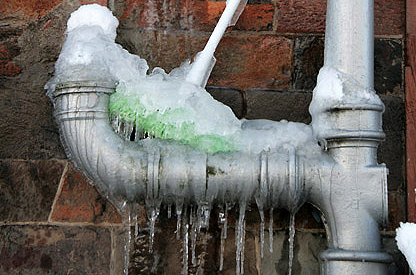Safeguarding Pipes from Freezing Damage: Key Strategies
Safeguarding Pipes from Freezing Damage: Key Strategies
Blog Article
What are your opinions about How to prepare your home plumbing for winter weather?
:strip_icc()/snow-outdoor-faucet-pipes-4af65d1e5e904fb1aa7bf74071fe5d89.jpg)
Winter can damage your plumbing, particularly by freezing pipes. Here's just how to stop it from taking place and what to do if it does.
Intro
As temperatures drop, the threat of icy pipes increases, possibly causing costly repairs and water damages. Comprehending how to stop frozen pipes is vital for house owners in cold environments.
Understanding Icy Pipes
What triggers pipelines to freeze?
Pipelines ice up when subjected to temperature levels below 32 ° F (0 ° C) for expanded durations. As water inside the pipes ices up, it expands, putting pressure on the pipeline wall surfaces and potentially triggering them to break.
Risks and damages
Frozen pipelines can cause water system disruptions, home damages, and pricey repairs. Ruptured pipes can flood homes and create considerable structural damage.
Signs of Frozen Pipes
Recognizing icy pipelines early can stop them from breaking.
How to identify icy pipelines
Search for lowered water circulation from faucets, unusual odors or sounds from pipelines, and visible frost on subjected pipes.
Avoidance Tips
Shielding susceptible pipes
Cover pipelines in insulation sleeves or use warmth tape to secure them from freezing temperatures. Concentrate on pipes in unheated or external areas of the home.
Home heating methods
Maintain interior areas effectively heated, particularly locations with plumbing. Open up closet doors to allow cozy air to flow around pipes under sinks.
Securing Exterior Plumbing
Garden pipes and outdoor faucets
Detach and drain pipes garden hoses prior to winter season. Mount frost-proof faucets or cover outdoor faucets with shielded caps.
What to Do If Your Pipelines Freeze
Immediate actions to take
If you presume icy pipes, keep faucets available to relieve pressure as the ice melts. Make use of a hairdryer or towels soaked in warm water to thaw pipes slowly.
Long-Term Solutions
Structural modifications
Take into consideration rerouting pipes away from exterior walls or unheated locations. Add extra insulation to attic rooms, basements, and crawl spaces.
Updating insulation
Invest in high-quality insulation for pipelines, attic rooms, and wall surfaces. Appropriate insulation aids maintain constant temperature levels and reduces the risk of frozen pipes.
Final thought
Protecting against icy pipelines requires proactive measures and quick responses. By understanding the causes, signs, and preventive measures, homeowners can protect their pipes throughout winter.
5 Ways to Prevent Frozen Pipes
Drain Outdoor Faucets and Disconnect Hoses
First, close the shut-off valve that controls the flow of water in the pipe to your outdoor faucet. Then, head outside to disconnect and drain your hose and open the outdoor faucet to allow the water to completely drain out of the line. Turn off the faucet when done. Finally, head back to the shut-off valve and drain the remaining water inside the pipe into a bucket or container. Additionally, if you have a home irrigation system, you should consider hiring an expert to clear the system of water each year.
Insulate Pipes
One of the best and most cost-effective methods for preventing frozen water pipes is to wrap your pipes with insulation. This is especially important for areas in your home that aren’t exposed to heat, such as an attic. We suggest using foam sleeves, which can typically be found at your local hardware store.
Keep Heat Running at 65
Your pipes are located inside your walls, and the temperature there is much colder than the rest of the house. To prevent your pipes from freezing, The Insurance Information Institute suggests that you keep your home heated to at least 65 degrees, even when traveling. You may want to invest in smart devices that can keep an eye on the temperature in your home while you’re away.
Leave Water Dripping
Moving water — even a small trickle — can prevent ice from forming inside your pipes. When freezing temps are imminent, start a drip of water from all faucets that serve exposed pipes. Leaving a few faucets running will also help relieve pressure inside the pipes and help prevent a rupture if the water inside freezes.
Open Cupboard Doors
Warm your kitchen and bathroom pipes by opening cupboards and vanities. You should also leave your interior doors ajar to help warm air circulate evenly throughout your home.

I was shown that editorial about How to prepare your home plumbing for winter weather from an associate on a different web property. Sharing is caring. Helping people is fun. I truly appreciate your readership.
Call Today Report this page